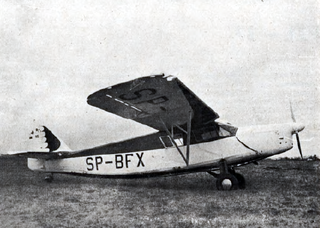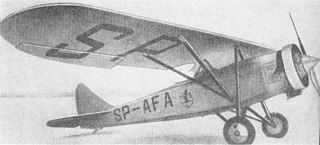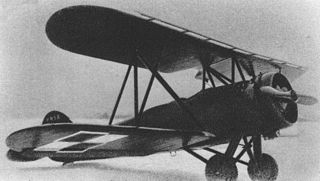
PZL was the main Polish aerospace manufacturer of the interwar period, and a brand of their aircraft. Based in Warsaw between 1928 and 1939, PZL introduced a variety of well-regarded aircraft, most notably the PZL P.11 fighter, the PZL.23 Karaś light bomber, and the PZL.37 Łoś medium bomber.
RWD was a Polish aircraft construction bureau active between 1928 and 1939. It started as a team of three young designers, Stanisław Rogalski, Stanisław Wigura and Jerzy Drzewiecki, whose names formed the RWD acronym.

The RWD 8 was a Polish parasol wing monoplane trainer aircraft produced by RWD. It was used from 1934 to 1939 by the Polish Air Force and civilian aviation.

Plage i Laśkiewicz was the first Polish aerospace manufacturer, located in Lublin and manufacturing aircraft under Lublin name. Full name was: Zakłady Mechaniczne E. Plage i T. Laśkiewicz – Mechanical Works E. Plage & T. Laśkiewicz. The factory produced aircraft between 1920 and 1935, when it was nationalized as the Lubelska Wytwórnia Samolotów.

The RWD-14 Czapla was a Polish army cooperation aircraft, designed in the mid-1930s by the RWD team, and produced in the LWS factory from 1938. A series of 65 aircraft were built and most were used by the Polish Air Force observation squadrons during World War II in 1939.

Lubelska Wytwórnia Samolotów was a Polish aerospace manufacturer, located in Lublin, created in 1936 from Plage i Laśkiewicz works and produced aircraft between 1936 and 1939.

The RWD-10 was a Polish aerobatics sports plane, single-seat parasol wing monoplane, used from 1933 to 1939 and constructed by the RWD team.

The WZ.X was the Polish reconnaissance aircraft designed in the mid-1920s and manufactured in the Centralne Warsztaty Lotnicze (CWL) - Central Aviation Workshops in Warsaw. It was the first combat aircraft of own design built in Poland, in a small series.

Lt. Col. Władysław Toruń was a Polish aviator and military pilot, and one of the pioneers of Polish aviation.

The RWD-15 was a Polish touring aircraft of 1937, designed by the RWD team and built by the Doświadczalne Warsztaty Lotnicze (DWL).

Podlaska Wytwórnia Samolotów was a Polish aerospace manufacturer between 1923 and 1939, located in Biała Podlaska.
Lotnicze Warsztaty Doświadczalne (LWD) was the Polish aerospace manufacturer and construction bureau, located in Łódź, active between 1945 and 1950. The name meant Aircraft Experimental Workshops. It was the first Polish post-war aerospace construction bureau.

PZL.12 (PZL-H) was a prototype of a Polish amphibious flying boat designed and built in 1931 by Zygmunt Puławski, a pioneering Polish designer. He was killed in a crash involving this design.

The PZL Ł.2 was a Polish Army cooperation and liaison aircraft, built in 1929 in the Polskie Zakłady Lotnicze (PZL) in Warsaw. Only a small series of 31 aircraft, including prototype, were made, and used by the Polish Air Force in the 1930s. The aircraft was known in Poland for accomplishing of a long-distance tour around Africa in 1931.
Samolot was the Polish aerospace manufacturer, located in Poznań and active between 1924 and 1930. It manufactured among others aircraft under the Bartel name. The name Samolot itself simply means airplane in Polish.
Doświadczalne Warsztaty Lotnicze (DWL) was the Polish aircraft manufacturer, active in 1933-1939. It was a home of the RWD construction team and manufactured aircraft under a brand RWD.

The PWS-1 was a Polish two-seat fighter and reconnaissance aircraft constructed by Podlaska Wytwórnia Samolotów (PWS) in 1927. It remained a prototype for its entire lifespan.

The PZL.4 was a Polish three-engine passenger aircraft for 10 passengers, built in PZL factory in 1932, which remained a prototype. It was the first Polish-designed and produced multi-engine plane.

The PWS-6, was a Polish liaison aircraft, developed in 1930 by the PWS, that remained a prototype.

Zbigniew Juliusz Babiński was a Polish military and sports aviator.















